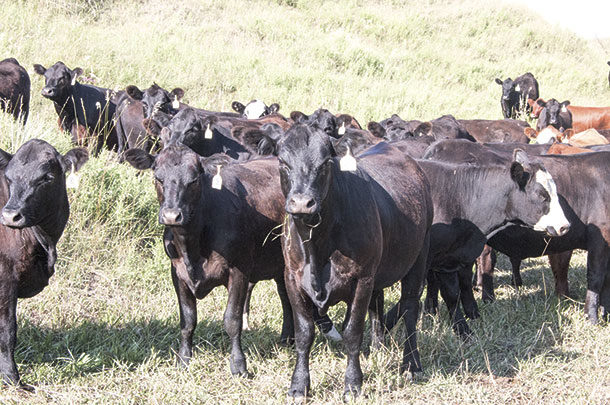And while corn silage (a member of the grass family) continues to be heavily relied upon as a cattle feed, increasing numbers of beef producers with small herds are opting to leave corn out of the diet due to the controversies surrounding both genetic engineering and other environmental and societal issues associated with growing corn for animal consumption.
Other annuals, such as barley and oats, are also grown for cattle feed but in far less amounts compared to corn.
Therefore, beef producers must focus on high-quality grasses and legumes for the majority of their cattle’s nutrition throughout the year. Beef raised in feedlots continues to dominate the beef markets.
However, grass-fed beef (including legumes) has been a growing industry for many years and continues to grow its market share and niche. Pasture grazing is at the center of this nutrition model, and well-managed pastures are necessary to provide the nutrition when grains and other commodity byproducts are intentionally omitted from diets.
Forages in the early vegetative stage – those that are fairly immature with no flowering or seeds developing – provide the most nutrition in pastures. Good pasture programs match forage quantity and quality with the nutritional needs of cows and calves throughout the year.
Nutritional requirements peak for a cow-calf operation between calving and re-breeding. Operations that have a late-winter/early spring calving must have optimal forage quality available from spring until mid-summer. For fall calving, the best forages must be available throughout the winter months.
The challenge for all graziers and grass farmers is developing and maintaining pastures with a diversified selection of forages (both perennial and annual) that will provide high-quality and maximum nutrition during the months when cows and calves need it most. It takes a combination of both warm-season and cool-season grasses to keep a pasture producing optimal nutrition for many months of the year.
While the best nutrition comes from forages in the early vegetative stage for cows and calves to maximize nutrient intake, it also requires mature plants that will enable a cow’s rumen to remain healthy. High-protein forages usually don’t have high levels of fiber, which are crucial for the rumen to operate. Therefore, a well-managed pasture system should have a combination of early and late vegetative stages at all times.
The grass farmer must learn which species of grasses and legumes grow best in a given region and plant those different combinations based on calving cycles in the herd. This varies widely across the U.S., with the southern tier of states having warmer and longer growing conditions compared to the northern tier of states that experience snow and freezing temperatures many months of the year.
According to recommendations published by the University of Arkansas, grass farmers should take regular inventory of the different forage species in their pastures. Forage inventories give a snapshot assessment of the forage species in each pasture. Inventories show what is currently growing in a pasture, the pasture condition due to the effects of past management and provide information to help plan the forage transition from one season to the next.
Making inventories for spring, summer and fall reveals the seasonal profile of forage and weed species and indicates whether sufficient forage species diversity exists on the farm for a season-long grazing system. This information is useful for pasture planning, especially in mixed-species pastures, because grazing or fertilizer management can be adjusted to ensure growth of different forages for each season or to reduce weed competition.
Selecting a grazing system to manage grazing allows farmers to plan for the seasonal forage transitions as the grazing season progresses. Growth of cool-season forage species declines as summer approaches, while growth rate of warm-season forages increases. Having a pasture with only cool-season species means the overall nutrition coming from the pasture will decline as weather warms. This will result in slower weight gains during the summer season for winter calves.
In mixed pastures, managing the seasonal transition to utilize forages as they grow is important. If spring forages are allowed to become too mature, livestock will refuse them, and the resulting mature, heavy overgrowth creates excessive shading of underlying summer forages.
This shading reduces summer forage growth and grazing for the next season in that pasture. Subdividing the pasture with temporary electric fence or changing the stocking rate allows more control of the forage utilization rate by increasing or decreasing stock density.
Increasing stock density in late spring to remove the spring forage canopy allows more sunlight to reach emerging summer forages. This sets up a desirable forage transition from spring grazing to summer grazing in the same pasture. Information gained from forage inventories shows which forages will be potentially available before, during and after each seasonal transition.
It’s highly recommended legumes such as alfalfa and clover be included as part of the pasture forage profile. Legumes are natural nitrogen fixers and benefit the other grass species with the nitrogen that helps fertilize and enrich the soil.
While legumes are often higher in protein in the early vegetative stage than grasses, they mature quickly during warm weather, and nutritional value declines. Legumes are warm-season forages that go dormant during the winter.
Grass farmers must also be prepared to bale or ensile some of the forages when a pasture is in danger of getting too mature and there’s not enough livestock to stay ahead of the growth. This forage can be stored for use during the winter months when pastures go dormant.
While hot weather and lack of rainfall can damage or destroy forages in a pasture, the most common cause of pastures failing and being unable to sustain livestock is overgrazing. Stands of grasses and legumes are stressed when grazed too aggressively, and root systems begin to suffer regardless of what grass species is planted.
As roots are stressed, the soil biology is also affected as micro-organisms begin to die off. A successful pasture system and the diversity of grasses that it supports is an ecosystem unto itself.
Pastures require time to recover after they’ve been grazed. Weeds will quickly invade pastures where foliage is sparse. The key to maintaining a healthy pasture is for plants to retain plenty of leaf throughout the season that will support necessary photosynthesis to keep roots healthy.
Central to maintaining a pasture ecosystem in a healthy condition requires knowing when to plant or re-seed complementary forages at the correct time of the year. Also deciding on a grazing system such as rotational or a continuous system is critical to the sustainability of pastures as well as maintaining the daily gain targets for the herd.
To get the most benefit out of any pasture system, grass farmers must plan well in advance what the stocking densities will be and what forage species will be the most productive in the regions where they live. ![]()
PHOTO: Heifers graze a carefully managed diversified pasture near Loup City, Nebraska, on the Split Ear Ranch. Photo by Lynn Jayne.

-
John Hibma
- Consulting Ruminant Nutritionist
- South Windsor, Connecticut
- Email John Hibma










